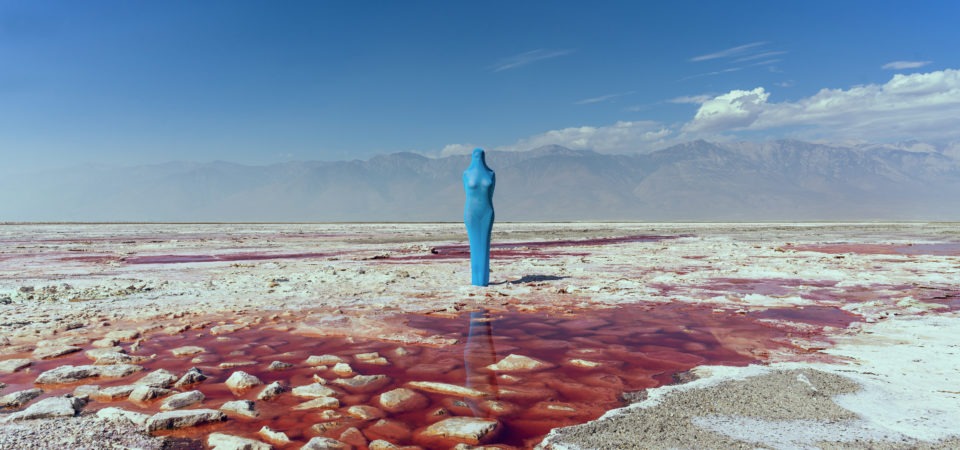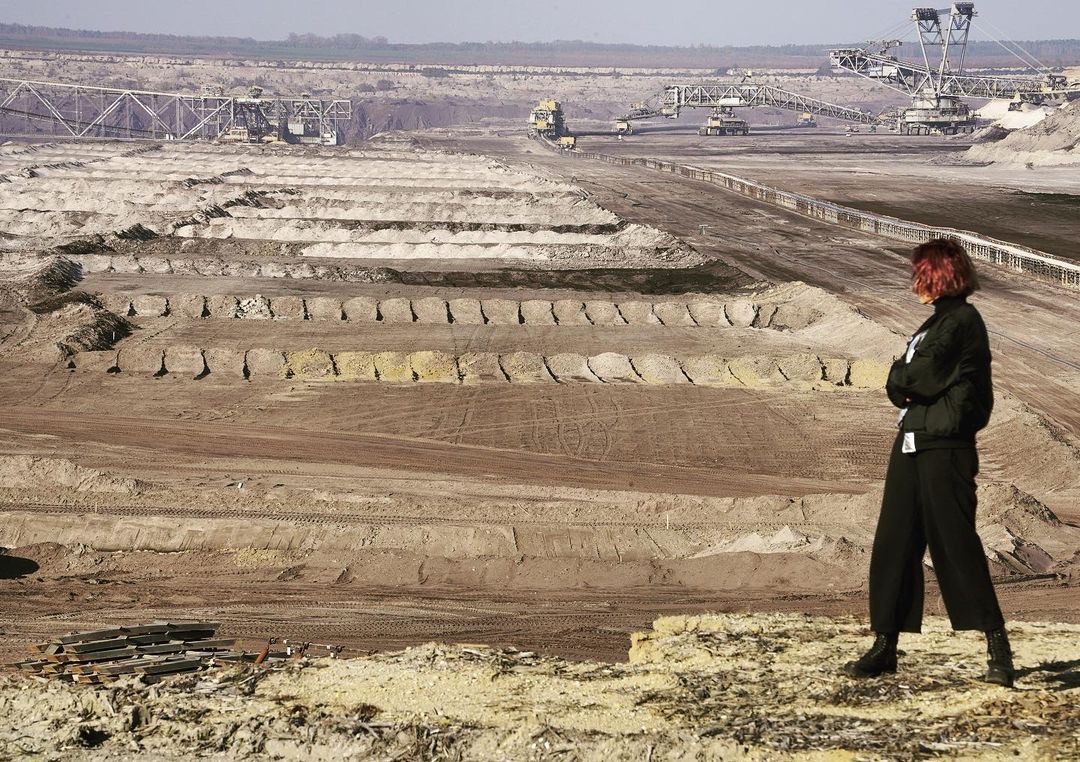
Liz Miller Kovacs on location at the Wezlow Süd open-pit coal mine.
Photo: Michael Robideau © 2021
In March of 2020, we were living in a converted industrial space in the heart of downtown Los Angeles, and the first wave of coronavirus was imminent. Tipped off to the upcoming lockdowns in Los Angeles County we fled our petri dish of a home for an indefinite stay at a friend’s vacant cottage in Joshua Tree. Over the course of three months, Michael Robideau assisted artist Liz Miller Kovacs. This time served as an incubation period–not for Covid-19–but a new body of work that was more relevant than ever given the global interdependency and precarity of life under late-stage capitalism.

Liz Miller Kovacs, “Shell and Bone,”
(with creative direction by Cyrina Hadad) © 2019
On prior excursions into the SoCal desert in 2018, we shot part of a series titled Hypothetical Artifacts. This series was imagined as an assortment of performative interventions where Miller Kovacs attempts to merge her vulnerable body with inhospitable landscapes. Her motivation was to reconnect with a dormant nature at a time in history when our lifestyle is increasingly at odds with ecological thinking. This series also sought to honor and expand upon the work of past female-identified artists such as Ana Mendieta, Judy Chicago, and Laura Aguilar. As a process-based and site-specific project it also functioned as a ritual meditation upon the cycle of life and mortality.
Hypothetical Artifacts envisioned what landscapes might look like in a post-human world. The first two desert locations chosen had extreme enough conditions apropos to the concept: Sunfair dry lake bed, which naturally drained during the early Holocene; and Bombay Beach at the Salton Sea, which was once dry but artificially flooded due to industrial intervention and human error. Sunfair dry lake bed is in close proximity to US military training infrastructure and is informally used as a shooting range, while Bombay beach is a shoreline composed entirely of the bones of decaying fish from the Salton Sea, which is so saline and polluted with agricultural run off as to be toxic to most forms of aquatic life.
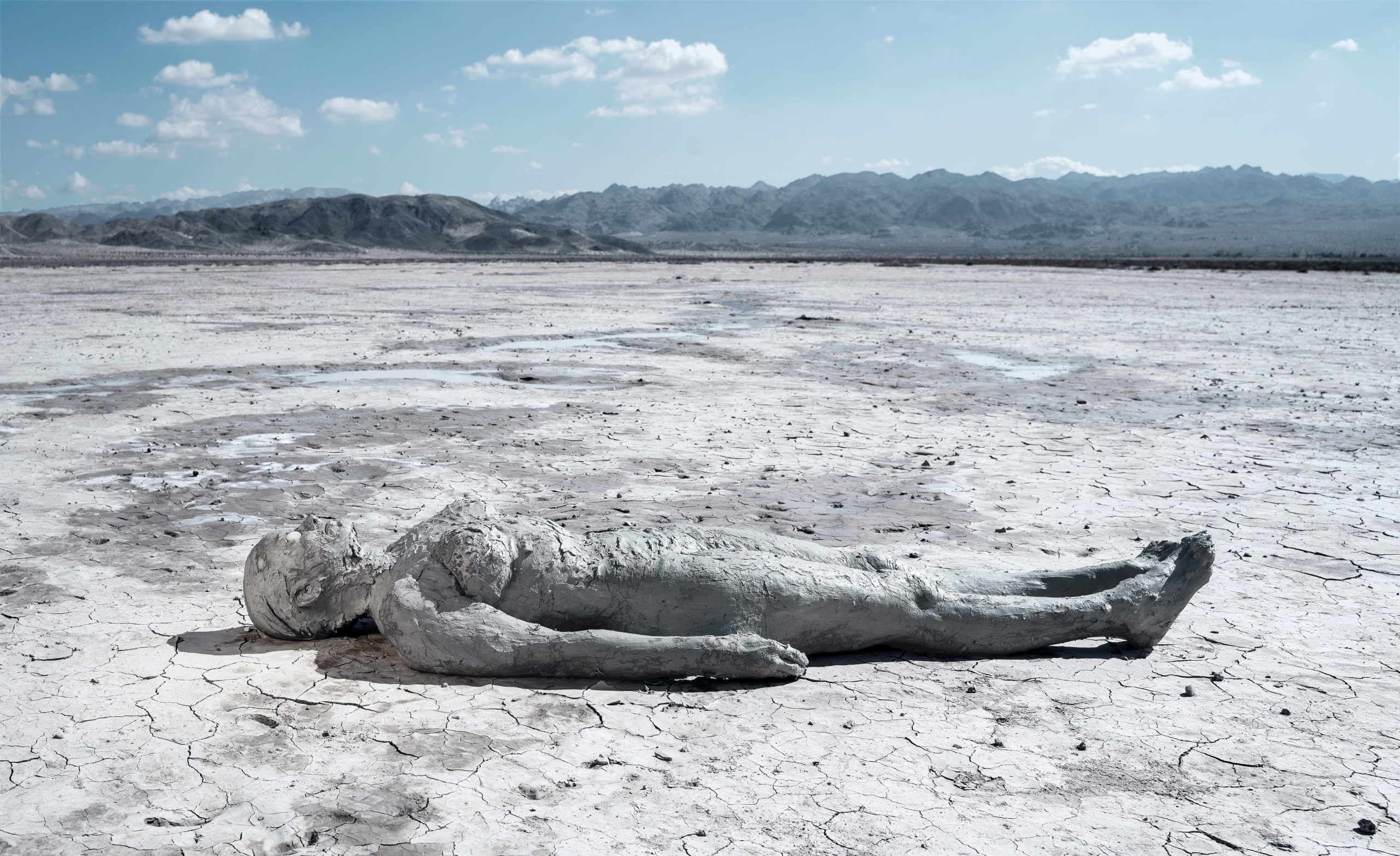
Liz Miller Kovacs, “Lakebed,”
(with creative direction by Cyrina Hadad) © 2019
The execution of these past projects required a small team, but this was now unfeasible as we decided to completely isolate ourselves due to a lack of knowledge about the virus. Longing for an escape from the monotony of lockdown, Miller Kovacs started researching new and interesting landscapes in the region which revealed several nearby sites for further investigation. Two were selected for potential projects: National Chloride company’s salt evaporation canals in Amboy, iconic for its sparkling turquoise water and Halite crystal formations; and Owens Lake in Inyo County, home to several extraction plants including Borax and Rio Tinto, and notorious for the halophilic bacteria that give the saline water a seasonal red tinge when they bloom.
Water in an Amboy chloride evaporation pool (left) and Owens Lake (right). Liz Miller Kovacs © 2020
These landscapes were constructed by inverse processes: Amboy salt flats consist of a series of ponds that were purposefully pumped full of brine from below the earth to evaporate and leave behind consumer grade table salt; Owens Lake was drained to provide water to the growing city of Los Angeles, exposing dust from the lake bed which created an environmental disaster and severely affected local air quality. In 2006, The Los Angeles Department of Water and Power installed a large-scale shallow flooding system to mitigate the dust problem and allow the lake to resume its role in supporting migratory birds
In these two shoots, Miller Kovacs had the idea to incorporate a sheer synthetic stocking of various colors to enshroud her body and highlight the human silhouette.
These colors would contrast with the vivid colors produced by the extraction site, highlighting the locations’ antagonism of humanity and the industrial process.
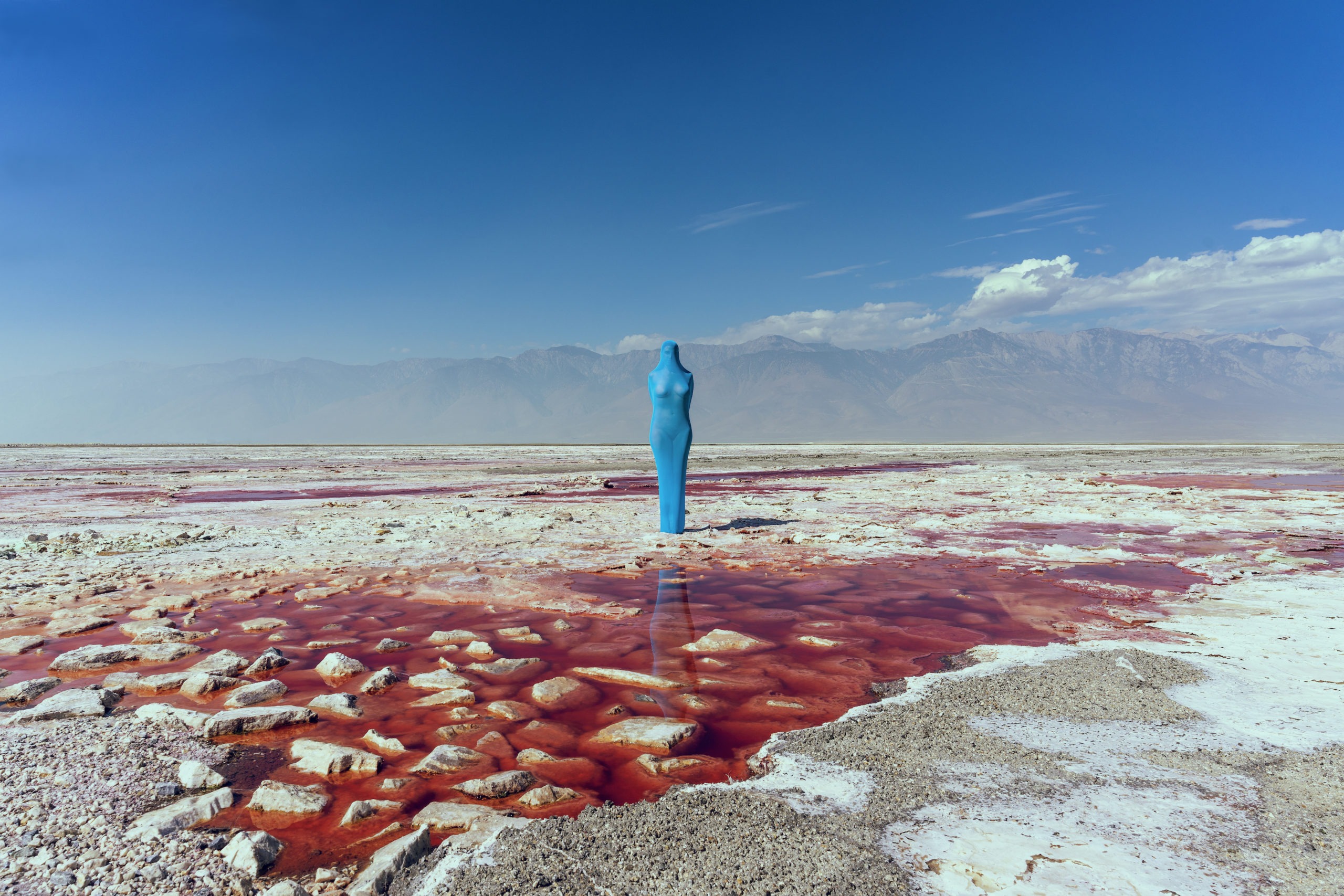
Liz Miller Kovacs, “Owens Venus,” ©2020
The outcome of these shoots was far more generative than we had expected. It was our fetishism of these surreal landscapes of destructive beauty that brought us there, but the work itself had layers of meaning and ramifications warranting a new series focusing on industrial extraction in the Capitalocene. Questions arose about the lack of transparency surrounding these manmade, alien landscapes, their numbers, and their impact on ecosystems.
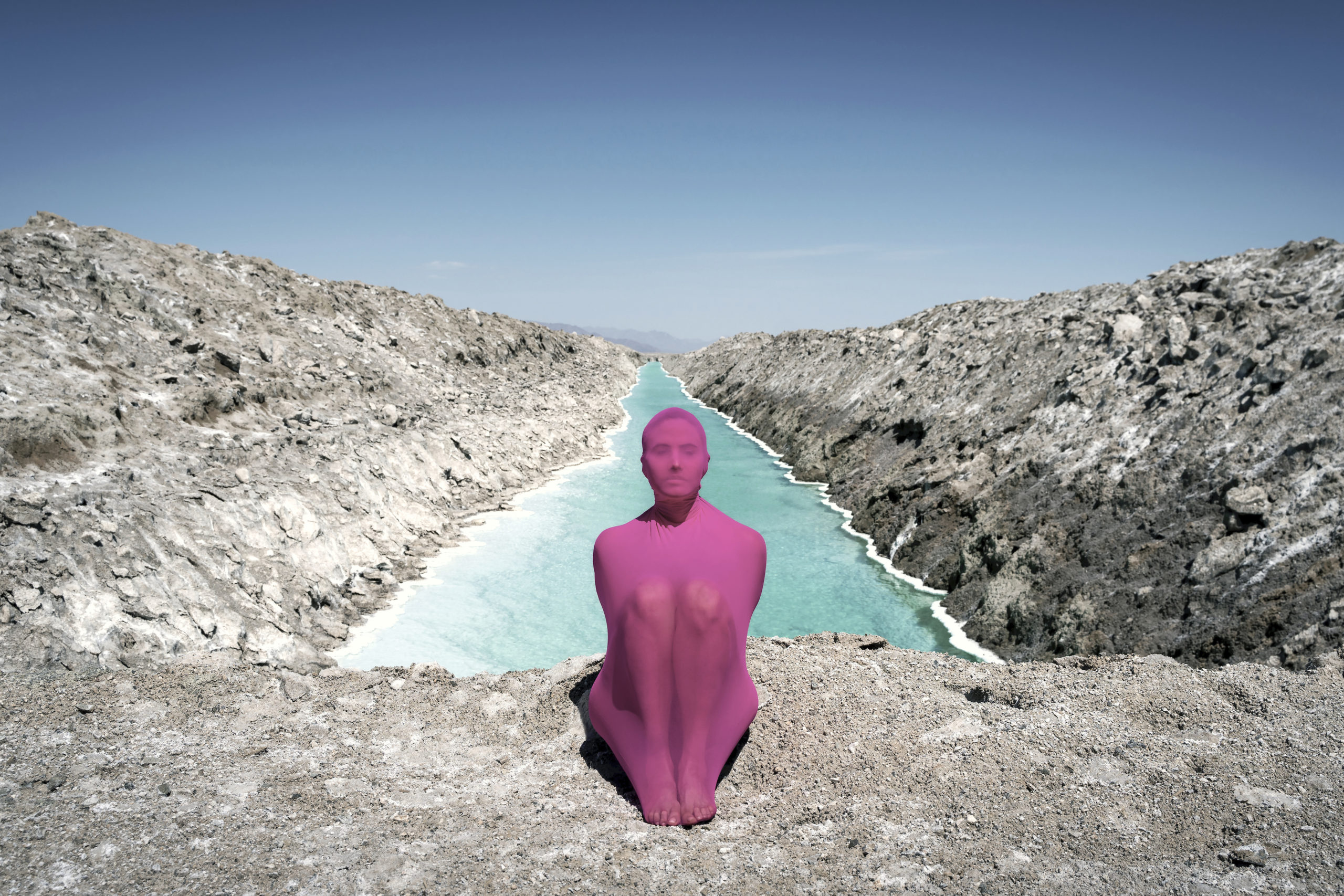
Liz Miller Kovacs, “Amboy Effigy,” ©2020
In these images the Anthropomorphic form is clearly coded as female, conjuring an alien shrink-wrapped Venus or other such deity from the future or beyond. The fabric could also be read as a membrane, protecting the tender human flesh from the inhospitable environment caused by the extraction, but also reminding us through a subtractive gesture that we are always under mediation. The images evoke a concurrent sense of fascination and horror, inviting contemplation of the contradictory conditions that structure our reality. These scenes are intended to remind us that globalized culture must reimagine its relationship with the land and its resources. We cannot afford to wait.

Michael Robideau at Garzweiler open-pit coal mine.
Photo: Liz Miller Kovacs ©2020
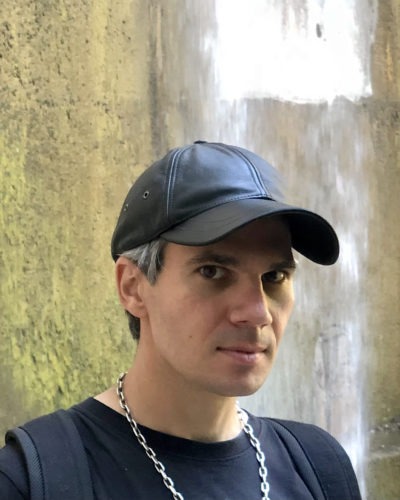 Michael Robideau is a philosopher and musician currently based in Berlin.
Michael Robideau is a philosopher and musician currently based in Berlin.
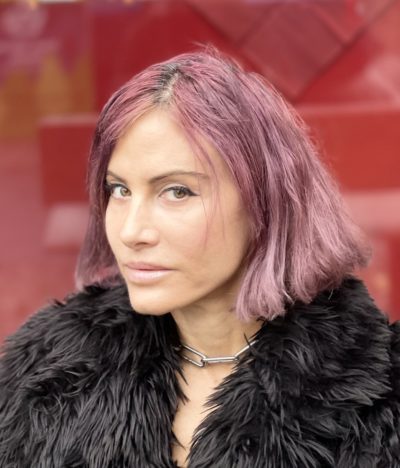 Liz Miller Kovacs is an interdisciplinary artist based in Berlin. She has exhibited her works in public art centers and galleries around North America, Europe, Asia, and Australia. Miller Kovacs completed a Visual Arts Ph.D. at Sydney College of the Arts and a MFA in New Genres from the San Francisco Art Institute
Liz Miller Kovacs is an interdisciplinary artist based in Berlin. She has exhibited her works in public art centers and galleries around North America, Europe, Asia, and Australia. Miller Kovacs completed a Visual Arts Ph.D. at Sydney College of the Arts and a MFA in New Genres from the San Francisco Art Institute
This article is part of the MAHB Arts Community‘s “More About the Arts and the Anthropocene”. If you are an artist interested in sharing your thoughts and artwork, as it relates to the topic, please send a message to Michele Guieu, Eco-Artist and MAHB Arts Community coordinator: michele@mahbonline.org.
Thank you. ~

